© 2012 Halbert Katzen, JD
Prepared by Halbert Katzen, J.D. [11/25/11]
¶ Horsing Around Summary
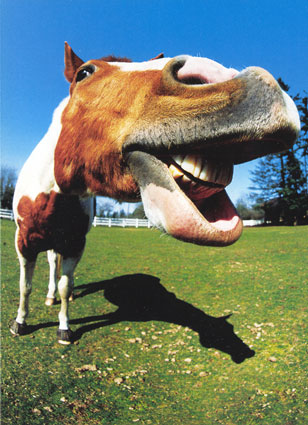
When The Urantia Book was published in 1955, archaeological evidence did not exist to support its statements about where and when the domestication of the horse first occurred and how this cultural achievement migrated out to other cultures from its place of origin. More than fifty years after its publication, new archaeological discoveries in Saudi Arabia and Kazakhstan reveal notable support to The Urantia Book’s depiction of this phase of advancing civilization.
The authors of The Urantia Book go into a certain degree of detail regarding the domestication of the horse, asserting that this started in Mesopotamia and spread to the world from this region. This information is presented as part of a comprehensive review of human history. In The Urantia Book the people that initially domesticated the horse are referred to as the “Andite” race. The following quotes provide some highlights of The Urantia Book’s depiction of horse domestication that relate to recent discoveries:
“The last three waves of Andites poured out of Mesopotamia between 8000 and 6000 B.C. These three great waves of culture were forced out of Mesopotamia by the pressure of the hill tribes to the east and the harassment of the plainsmen of the west.” UB 78:6.1
“The horse gave the dispersing Andites the hitherto nonexistent advantage of mobility, enabling the last groups of Andite cavalrymen to progress quickly …” UB 80:4.4
“Ten per cent of these fleeing Andites made their way across Arabia and entered Egypt.” UB 78:6.5
“Sixty-five per cent entered Europe by the Caspian Sea route …” UB 78:6.2
“Ten per cent . . . moved eastward through the Elamite highlands to the Iranian plateau and Turkestan.” UB 78:6.3
“The civilization of Turkestan was constantly being revived and refreshed by the newcomers from Mesopotamia, especially by the later Andite cavalrymen.” UB 78:5.3
A 2011 Reuters story, covering an archaeological discovery made in Saudi Arabia, reported, “The Maqar Civilization is a very advanced civilization of the Neolithic period. This site shows us clearly, the roots of the domestication of horses 9,000 years ago.”
In 2009 Reuters published a story on research results from an archaeological site in Kazakhstan. It stated, “Horses were first domesticated on the plains of northern Kazakhstan some 5,500 years ago-1,ooo years earlier than thought-by people who rode them and drank their milk, researchers said on Thursday.”
These archaeological sites are examples of how new discoveries increasingly support The Urantia Book’s statements about the domestication of the horse, both in terms of time period and location.
For a broader appreciation of the appearance and eventual absorption of the Adamite and Andite races, see the Adam and Eve Report, which is based on genetic and linguistic studies, and the Gobekli Tepe Report, which concerns an archaeological site in Turkey that dates back to over 11,000 years ago.
¶ Horsing Around Review
According to The Urantia Book, humanity originated as a result of a genetic mutation that occurred about one million years ago. Our religious traditions about Adam and Eve, it says, grew from a genetic uplift that occurred around 40,000 years ago. One of the peculiar aspects of this introduction of superior genetics into the human gene pool is that, though genetically superior, Adam and Eve’s genes had a retrogressing characteristic, meaning that each subsequent generation received an increasingly degraded version of the genetic uplift. This race, the Adamites, was in part responsible for the evolution of the Andite race, which is said to have one eighth to one sixth “Adamite” inheritance. (The Adamites are also referred to as the “violet race.”) The eventual absorption of the Adamites into the human gene pool gave rise to the Andites. This transition took place approximately 15,000 to 20,000 years ago.
The story about Adam and Eve in The Urantia Book, while largely different than the one found in the Old Testament, also has some similarities. Specifically, Adam and Eve had some problems that caused them to leave their first location (along the shores of the eastern Mediterranean, see the Garden Of Eden Report) and re-establish their newly forming civilization at a new location between the Tigris and Euphrates. Given our religious traditions about the origins of man and what the authors of The Urantia Book assert concerning human evolution, they, not surprisingly, chose to refer to this genetically superior couple as Adam and Eve.
Having this basic understanding of The Urantia Book’s depiction of human evolution is necessary for appreciating comments that will come up in the quotes below that relate to the domestication of the horse. The Andites originated in Mesopotamia, from where they migrated to most parts of the world. Regarding the Andites and their domestication of the horse, the authors state:
While the Andites poured into Europe in a steady stream, there were seven major invasions, the last arrivals coming on horseback in three great waves.[1]
The earlier expansions of the purer violet race were far more pacific than were those of their later semimilitary and conquest-loving Andite descendants. . . .
But the horse was the evolutionary factor which determined the dominance of the Andites in the Occident. The horse gave the dispersing Andites the hitherto nonexistent advantage of mobility, enabling the last groups of Andite cavalrymen to progress quickly around the Caspian Sea to overrun all of Europe. All previous waves of Andites had moved so slowly that they tended to disintegrate at any great distance from Mesopotamia. But these later waves moved so rapidly that they reached Europe as coherent groups, still retaining some measure of higher culture.[2]
The last three waves of Andites poured out of Mesopotamia between 8000 and 6000 B.C. These three great waves of culture were forced out of Mesopotamia by the pressure of the hill tribes to the east and the harassment of the plainsmen of the west. The inhabitants of the Euphrates valley and adjacent territory went forth in their final exodus in several directions:
. . .
Ten per cent of these fleeing Andites made their way across Arabia and entered Egypt.[3]
The recent discovery in Saudi Arabia evidencing domestication of the horse dates back to 7000 B.C. — right in the middle of the time period specified in The Urantia Book for when this cultural advance spread into Arabia. Other archaeological sites that provide strong evidence for horse domestication are at least three thousand years more recent than this one.
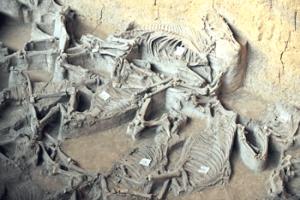
In late August 2011 news agencies around the world started publishing reports about this new site in Saudi Arabia. The following excerpts are taken from Reuters, the BBC, and Middle East Online:
Saudi Arabia is excavating a new archaeological site that will show horses were domesticated 9,000 years ago in the Arabian peninsula, the country’s antiquities expert said on Wednesday.
The discovery of the civilization, named al-Maqar after the site’s location, will challenge the theory that the domestication of animals took place 5,500 years ago in Central Asia, said Ali al-Ghabban, Vice-President of Antiquities and Museums at the Saudi Commission for Tourism & Antiquities.
. . .
“The Maqar Civilization is a very advanced civilization of the Neolithic period. This site shows us clearly, the roots of the domestication of horses 9,000 years ago.”
The site also includes remains of mummified skeletons, arrowheads, scrapers, grain grinders, tools for spinning and weaving, and other tools that are evidence of a civilization that is skilled in handicrafts.[4]
Mr Ghabban said carbon-14 tests on the artifacts, as well as DNA tests on human remains also found there, dated them to about 7,000 BC.[5]
The remains of the civilization were found close to Abha, in southwestern Asir province, an area known to antiquity as Arabia Felix.
The civilization, given the name al-Maqari, used “methods of embalming that are totally different to known processes,” Ghabban said.
Among the remains found at the site are statues of animals such as goats, dogs, hawks, and a metre-tall bust of a horse, Ghabban said.
“A statue of an animal of this dimension, dating back to that time, has never been found anywhere in the world,” Ghabban said.[6]
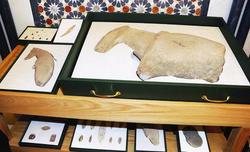
Along with supporting The Urantia Book’s statements about horse domestication, this archaeological site in Saudi Arabia also provides evidence for the book’s commentary about cultural developments like weaving and the domestication of animals in general.
These Andites inaugurated new advances throughout Eurasia and North Africa. From Mesopotamia through Sinkiang the Andite culture was dominant, and the steady migration toward Europe was continuously offset by new arrivals from Mesopotamia. But it is hardly correct to speak of the Andites as a race in Mesopotamia proper until near the beginning of the terminal migrations of the mixed descendants of Adam. By this time even the races in the second garden had become so blended that they could no longer be considered Adamites.[7]
Adam’s caravan had carried the seeds and bulbs of hundreds of plants and cereals of the first garden with them to the land between the rivers; they also had brought along extensive herds and some of all the domesticated animals. Because of this they possessed great advantages over the surrounding tribes. They enjoyed many of the benefits of the previous culture of the original Garden.[8]
The Adamites greatly excelled the surrounding peoples in cultural achievement and intellectual development. They produced the third alphabet and otherwise laid the foundations for much that was the forerunner of modern art, science, and literature. Here in the lands between the Tigris and Euphrates they maintained the arts of writing, metalworking, pottery making, and weaving and produced a type of architecture that was not excelled in thousands of years.[9]
Not surprisingly, material in this report overlaps with issues that will be addressed in the upcoming Animal Domestication Report. That report will cover a wider time span because The Urantia Book indicates that animal husbandry began about 500,000 years ago, long before the domestication of the horse. Being less comprehensive in nature, this report will stay more limited in its focus and not take up the issues raised by the discovery of other animals and embalmed humans at the Maqar site in Saudi Arabia.
To say from a Urantia Book perspective exactly why the domestication of the horse did not come until much later relative to other animals would be speculative. The authors do not give a specific reason.
Though the more recent discovery in Saudi Arabia of horse domestication 9,000 years ago lends more impressive support to The Urantia Book’s comments on this subject than the one in Kazakhstan, the 2009 discovery confirming early horse domestication in Kazakhstan also supports The Urantia Book’s depiction of the spread the Andite culture. The Urantia Book states:
The last three waves of Andites poured out of Mesopotamia between 8000 and 6000 B.C.
. . .
Ten per cent . . . moved eastward through the Elamite highlands to the Iranian plateau and Turkestan…
The civilization of Turkestan was constantly being revived and refreshed by the newcomers from Mesopotamia, especially by the later Andite cavalrymen.[10]
The whole inhabited world, outside of China and the Euphrates region, had made very limited cultural progress for ten thousand years when the hard-riding Andite horsemen made their appearance in the sixth and seventh millenniums before Christ.[11]
The Andites of Turkestan were the first peoples to extensively domesticate the horse, and this is another reason why their culture was for so long predominant. By 5000 B.C. the Mesopotamia, Turkestan, and Chinese farmers had begun the raising of sheep, goats, cows, camels, horses, fowls, and elephants. They employed as beasts of burden the ox, camel, horse, and yak.[12]
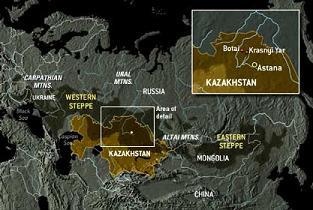
In March 2009 Science magazine published a report revealing how the discovery in Kazakhstan would have been the best, most recent discovery to lend support to The Urantia Book on this subject, just a few years ago. The abstract of that report reads:
Horse domestication revolutionized transport, communications, and warfare in prehistory, yet the identification of early domestication processes has been problematic. Here, we present three independent lines of evidence demonstrating domestication in the Eneolithic Botai Culture of Kazakhstan, dating to about 3500 B.C.E. Metrical analysis of horse metacarpals shows that Botai horses resemble Bronze Age domestic horses rather than Paleolithic wild horses from the same region. Pathological characteristics indicate that some Botai horses were bridled, perhaps ridden. Organic residue analysis, using δ13C and δD values of fatty acids, reveals processing of mare’s milk and carcass products in ceramics, indicating a developed domestic economy encompassing secondary products.[13]
In covering the Science report, a Reuters article contextualized the research results in this way:
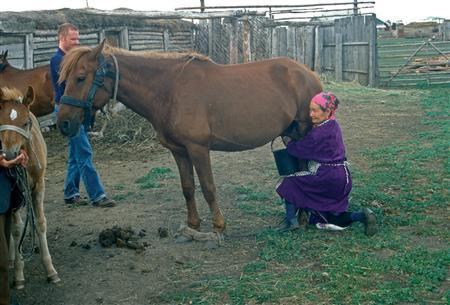
Horses were first domesticated on the plains of northern Kazakhstan some 5,500 years ago- 1,000 years earlier than thought-by people who rode them and drank their milk, researchers said on Thursday.
Taming horses changed human history, influencing everything from transport to agriculture to warfare. But experts have struggled to pinpoint when and where it first happened.
Now archaeologists think they have the answer, after finding the world’s oldest horse farm among the Kazakh people of the ancient Botai culture.
Remains of bones, teeth and shards of pottery, used to store mare’s milk, all indicate horses were selectively bred and exploited for domestic use east of the Ural mountains around 2,000 years before they are known to have been used in Europe.
Alan Outram from Britain’s University of Exeter said the new findings, published in the journal Science, changed understanding of how early societies developed.
“Once you have horse riding you’ve got much greater transport and trade capability, as well as potential advantages in warfare,” he said in a telephone interview.
“If it was happening this early, then you’ve got to think about those forces for social and economic change happening earlier too-and it is possible that there are yet earlier sites we haven’t found.” [How prophetic!]
Archaeologists have suspected for some time that the Botai people were the world’s first horsemen but previous sketchy evidence has been disputed, with some arguing that the Botai simply hunted horses.[14]
In an article for Ars Technica, Chris Lee contextualizes and summarizes the findings in the original research report as follows:
A recent publication in Science takes a fresh look at the domestication of the horse. The authors show that the horse is likely to have been domesticated independently of other animals, in areas outside of the fertile crescent. …
. . .
The accelerated evolutionary changes, driven by artificial selection, can alter the modern domesticated species so radically that it becomes difficult to identify its paleolithic origins.
The horse is no different, but in this case, the changes are not so radical that we cannot trace the horse lineage. In fact, one key way to distinguish early domesticated horses from paleolithic wild horses is the width of the leg bones: humans have decided that they like their horses with long, thin legs. The researchers have used this to show that horse remains that were concurrent with the Botai culture (located in modern-day northern Kazakhstan) were more like modern horses than the concurrent wild horses from nearby Siberia.
The authors then went on to strengthen their case by examining the wear marks on the teeth. Modern horses have distinctive wear patterns due to the fact that they have bits in their mouths. Five of the 15 mandibles from the site exhibited wear marks that could be unambiguously attributed to spending a lot of their lives wearing a bridle. Of the remaining 10 mandibles, several had marks on the teeth that could be attributed to wearing a bridle, but were either not clear enough or didn’t have corresponding bone growth or wear on a related part of the jaw. Nevertheless, this confirms that the Botai at least had partly domesticated herds of horses by 3521 BCE.
Adding to these two lines of evidence are the residual fatty acids found in pottery shards found at Botai archaeological sites. In this case, the scientists infer the animal products that went into the pot by looking at the amount of C13 contained in specific fatty acids. This method can distinguish between milk fats and animal fats that originate from cows, sheep, and goats, which is important in terms of domestication because undomesticated animals are unlikely to let your average hunter-gatherer milk them. Unfortunately, C13 analysis doesn’t work as well for horses as it does for other animals. As a result, the researchers could clearly distinguish horse contributions from other animals, but not horse milk from horse meat.
To overcome this particular problem, the amount of deuterium in the fat was analyzed. The amount of deuterium varies annually between summer and winter values. Animal fats, which are obtained all year, reflect this variation in the pottery shards. Milk, on the other hand, is a summer food, and should only have the summer values of deuterium. Indeed, the researchers found this signature in certain fats, allowing them to classify those as horse-milk fats.
These lines of evidence all converge to one likely conclusion: the Botai had domesticated horses. Furthermore, they are remote from the agricultural societies of the time, and are likely to have achieved this remarkable feat independently.[15]
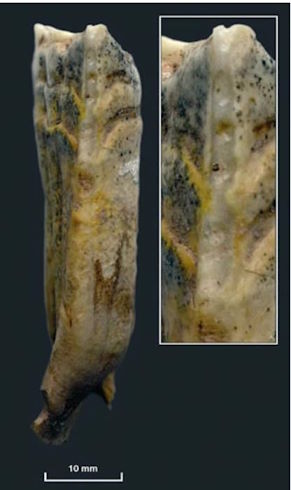
The close succession of the Saudi Arabia and Kazakhstan discoveries points to the accelerating pattern of new discoveries and scientific advances that increasingly provide closer corroborations of Urantia Book history. The upcoming Animal Domestication and Dog Domestication reports, while expanding the time period of animal domestication, essentially will be like this one-documentation of new support for the history in The Urantia Book. Intriguing as it is that new discoveries increasingly support statements in The Urantia Book about the history of our planet, this is a rather haphazard way (dependent on what gets discovered) to appreciate what the authors of The Urantia Book have to impart to us about the development of human civilization.
For a relatively quick Urantia Book perspective on the development of civilization, consider reading Chapter 81: “Development of Modern Civilization.” For a Urantia Book-based taxonomy of human evolution, see Eugenics, Race, and The Urantia Book: Appendix 1.
¶ External Links
- This report in UBTheNews webpage
- Other reports in UBTheNews webpage
- Topical Studies in UBTheNews webpage
- http://www.sciencedaily.com/releases/2009/03/090305141627.htm
- http://www.geosociety.org/news/pr/06-49.htm
- http://en.wikipedia.org/wiki/Domestication_of_the_horse
- http://query.nytimes.com/gst/fullpage.html?res=9~F0CE2DB133EF930A35752C0A965958260
- http://en.wikipedia.org/wiki/Domestication_of_the_horse
- http://www.reuters.com/article/scienceNews/idUSTTRE5246HI20090305
- http://archaeology.about.com/od/domestications/qt/horses.htm
- http://archaeology.about.com/b/2009/03/05/new-evidence-of-horse-domestication.htm
- http://www.geosociety.org/news/pr/06-49.htm (The Krasnyi Yar site)
- http://www.bbc.co.uk/news/world-middle-east-14658678
- http://arabiangazette.com/fresh-finds-in-saudi-arabia-may-alter-horses-domestication-history/ http://www.reuters.com/article/2011/08/25/uk-saudi-archaeology-idUSLNE77O01R20110825 http://www.middle-east-online.com/english/?id=47796
- http://www.biblicalarchaeology.org/daily/news/saudi-archaeologists-claim-earliest-evidence-ofhorse-domestication/
- http://www.pasthorizonspr.com/index.php/archives/08/2011/domestication-of-horses-may-stretchback-9000-years
- http://www.dailystar.com.lb/Culture/Art/2011/Aug-27/Saudi-excavation-shows-horses-weredomesticated-9000-years-ago.ashx#axzz1c1hNxILZ
- http://www.horsetalk.co.nz/news/2009/03/041.shtml
- http://onlinelibrary.wiley.com/doi/10.1111/j.1365-2052.2010.02038.x/full
¶ Footnotes:
Urantia Book UB 80:4.3,4 ↩︎
Urantia Book UB 78:6.1-3,5 ↩︎
http://www.reuters.com/article/2011/08/25/uk-saudi-archaeology-idUSLNE77001R20110825 ↩︎
Urantia Book UB 78:5.2,3 ↩︎
http://www.reuters.com/article/2009/03/05/us-horses-history-idUSTRE5246HI20090305 ↩︎
http://arstechnica.com/science/news/2009/03/domesticating-the-horse.ars ↩︎